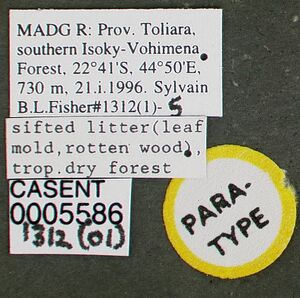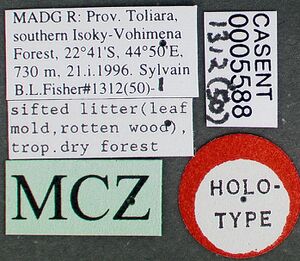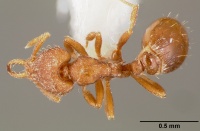Strumigenys lucomo
| Strumigenys lucomo | |
|---|---|

| |
| Scientific classification | |
| Kingdom: | Animalia |
| Phylum: | Arthropoda |
| Class: | Insecta |
| Order: | Hymenoptera |
| Family: | Formicidae |
| Subfamily: | Myrmicinae |
| Tribe: | Attini |
| Genus: | Strumigenys |
| Species: | S. lucomo |
| Binomial name | |
| Strumigenys lucomo Fisher, 2000 | |
A common, widespread Madagascar Strumigenys. This ant has been found in a wide range of forest habitats and has been collected nesting in the soil, in litter samples, in rotten wood and in dead twigs above the ground.
Identification
Bolton (2000) - A member of the scotti complex in the Strumigenys scotti-group. S. lucomo and Strumigenys lura form a pair of closely related species within the scotti-complex. They both have the dorsum of pronotum with one or more pairs of erect hairs in addition to a flagellate pair at humeral angles, mesonotum with 2 or 3 pairs of erect hairs, and the ventral spongiform tissue of petiolar peduncle in profile an irregular, narrow strip along the base of the peduncle.
S. lucomo can be distinguished from lura by the presence of a ventrally directed triangular tooth at the anterior end of the ventral spongiform lamella of petiolar peduncle when viewed in profile. In profile anterior end of ventral spongiform lamella of petiolar peduncle of lura is at most small and rounded. In addition, the lamella on the propodeal declivity of lucomo is narrow but conspicuous and continuous down the declivity while in lura the lamella is inconspicuous. See also under Strumigenys glycon.
Keys including this Species
Distribution
Latitudinal Distribution Pattern
Latitudinal Range: -13.962° to -22.68333°.
| North Temperate |
North Subtropical |
Tropical | South Subtropical |
South Temperate |
- Source: AntMaps
Distribution based on Regional Taxon Lists
Malagasy Region: Madagascar (type locality).
Distribution based on AntMaps
Distribution based on AntWeb specimens
Check data from AntWeb
Countries Occupied
| Number of countries occupied by this species based on AntWiki Regional Taxon Lists. In general, fewer countries occupied indicates a narrower range, while more countries indicates a more widespread species. |

|
Estimated Abundance
| Relative abundance based on number of AntMaps records per species (this species within the purple bar). Fewer records (to the left) indicates a less abundant/encountered species while more records (to the right) indicates more abundant/encountered species. |

|
Biology
|
Castes
Worker
Images from AntWeb
   
| |
| Paratype of Strumigenys lucomo. Worker. Specimen code casent0005586. Photographer April Nobile, uploaded by California Academy of Sciences. | Owned by CAS, San Francisco, CA, USA. |
   
| |
| Paratype of Strumigenys lucomo. Worker. Specimen code casent0005587. Photographer April Nobile, uploaded by California Academy of Sciences. | Owned by CAS, San Francisco, CA, USA. |
   
| |
| Holotype of Strumigenys lucomo. Worker. Specimen code casent0005588. Photographer April Nobile, uploaded by California Academy of Sciences. | Owned by MCZ, Cambridge, MA, USA. |
Nomenclature
The following information is derived from Barry Bolton's Online Catalogue of the Ants of the World.
- lucomo. Strumigenys lucomo Fisher, in Bolton, 2000: 688 (w.q.) MADAGASCAR.
Unless otherwise noted the text for the remainder of this section is reported from the publication that includes the original description.
Measurements of non-type worker specimens extend the range shown by the types-series: HL 0.46-0.49, HW 0.37-0.40, ML 0.21-0.24, MI 45-49, SL 0.26-0.31, SI 68-82 (7 measured). Specimens examined from localities other than Isoky-Vohimena lack the central short costulae at the base of the first gastral tergite and have a central clear area. In addition, specimens from Ankarana and Lokobe differ in having slightly thinner mandibles in profile and having only 2 pairs of hairs on the mesonotum but otherwise are similar to the type material. Their placement in lucomo is tentative and must be reassessed when additional collections from the west of Madagascar are made available.
Description
Worker
Holotype. TL 2.3, HL 0.52, HW 0.43, CI 83, ML 0.22, MI 42, SL 0.29, SI 67, PW 0.27, AL 0.56. Characters of scotti-complex. Mandibles in full-face view short, outer margins shallowly and evenly convex, sharply narrowed at base. Upper scrobe margin evenly and shallowly convex in full-face view, not bordered by a rim or flange, the eyes visible. Maximum diameter of eye approximately equal to maximum width of scape, with 3-4 ommatidia in longest row. Scape subcylindrical, curved and narrowed near base; hairs on leading edge slender, slightly flattened or spoon-shaped apically. Cephalic dorsum densely clothed with short, slender filiform ground-pilosity which are thickened apically. The upper scrobe margin fringed with sharply curved hairs which are flattened or spoon-shaped apically and are similar in size to those on the leading edge of the scape. Cephalic dorsum with 6 standing filiform hairs arranged in a transverse row of 4 close to the occipital margin and a more anteriorly situated pair. Pronotal humeral hair flagellate, dorsum also with one or more pairs of short suberect or erect hairs. Mesonotum with three pairs of hairs: a pair of standing filiform to narrowly remiform hairs on anterior margin, a shorter more posteriorly situated pair of erect filiform hairs, and an even shorter pair of erect fine hairs on posterior margin. Hairs on promesonotal dorsum appear easily abraded and are broken or missing in many of the paratypes. Propodeum with one pair of short, fine, posteriorly curved hairs immediately anterior of propodeal spines. Ground-pilosity as on head but the hairs are sparser. Dorsum of alitrunk in outline convex anteriorly and posteriorly shallowly convex and gently sloping to the declivity. Metanotal groove shallowly impressed. Anterior mesonotum without a conspicuous carina above the mesothoracic spiracle; mesopleural gland set in a small circular notch. Propodeal tooth triangular, lamellate, pointed apically, and subtended by a narrow lamella that is continuous down the declivity. Pronotal dorsum and sides longitudinally rugulose-striolate; mesonotal and propodeal dorsa reticulate-punctate. Sides of pleurae and propodeum smooth and peripherally punctulate. Postpetiole disc more or less smooth, faintly longitudinally striolate laterally. In profile ventral spongiform tissue of petiolar peduncle a narrow irregular strip along the base of the peduncle and with a ventrally directed narrow triangular spiniform tooth at anterior end, the deepest point of the curtain (excluding tooth) less than the maximum width of eye. Ventral spongiform tissue of postpetiole moderately developed. Basigastral costulae well developed and sharply defined, radiating on each side of a central area that includes shorter less developed costulae. Dorsal surface of petiole, postpetiole, and gaster with standing filiform hairs which are slightly thickened apically. Colour light brown.
Paratypes. TL 2.0-2.3, HL 0.49-0.52, HW 0.38-0.43, CI 75-85, ML 0.22-0.23, MI 43-45, SL 0.27-0.29, SI 66-75, PW 0.24-0.29, AL 0.50-0.58 (8 measured). As holotype.
Type Material
Holotype worker, Madagascar: Provo Toliara, southern Isoky-Vohimena Forest, 59 km. NE Sakaraha, 22°41'S, 44°50'E, 730 m., 21.i.1996, sifted litter (leaf mold, rotten wood) tropical dry forest #1312 (50)-1 (S. Razafimandimby & B. L. Fisher) (Museum of Comparative Zoology).
Paratypes. 17 workers and 1 queen (dealate) with same data as holotype but coded (1)-5, (2)-2, (3)-3, (4)-4, (5)-4, (6)-5, (18)-4, (22)-2, (24)-3, (26)-2, (29)-2, (35)-4, (36)-3, (40)-1, (48)-2 (The Natural History Museum, South African Museum).
References
- Fisher, B.L. 2000. The Malagasy fauna of Strumigenys. Pp. 612-696 in: Bolton, B. 2000. The ant tribe Dacetini. Memoirs of the American Entomological Institute. 65:1-1028. (page 688, worker described)
References based on Global Ant Biodiversity Informatics
- Bolton, B. 2000. The Ant Tribe Dacetini. Memoirs of the American Entomological Institute 65
- Ravelomanana A., and B. L. Fisher. 2013. Diversity of ants in burned and unburned grassland , and dry deciduous forest in the Beanka Reserve, Melaky Region, western Madagascar. Malagasy Nature 7: 171-183.

